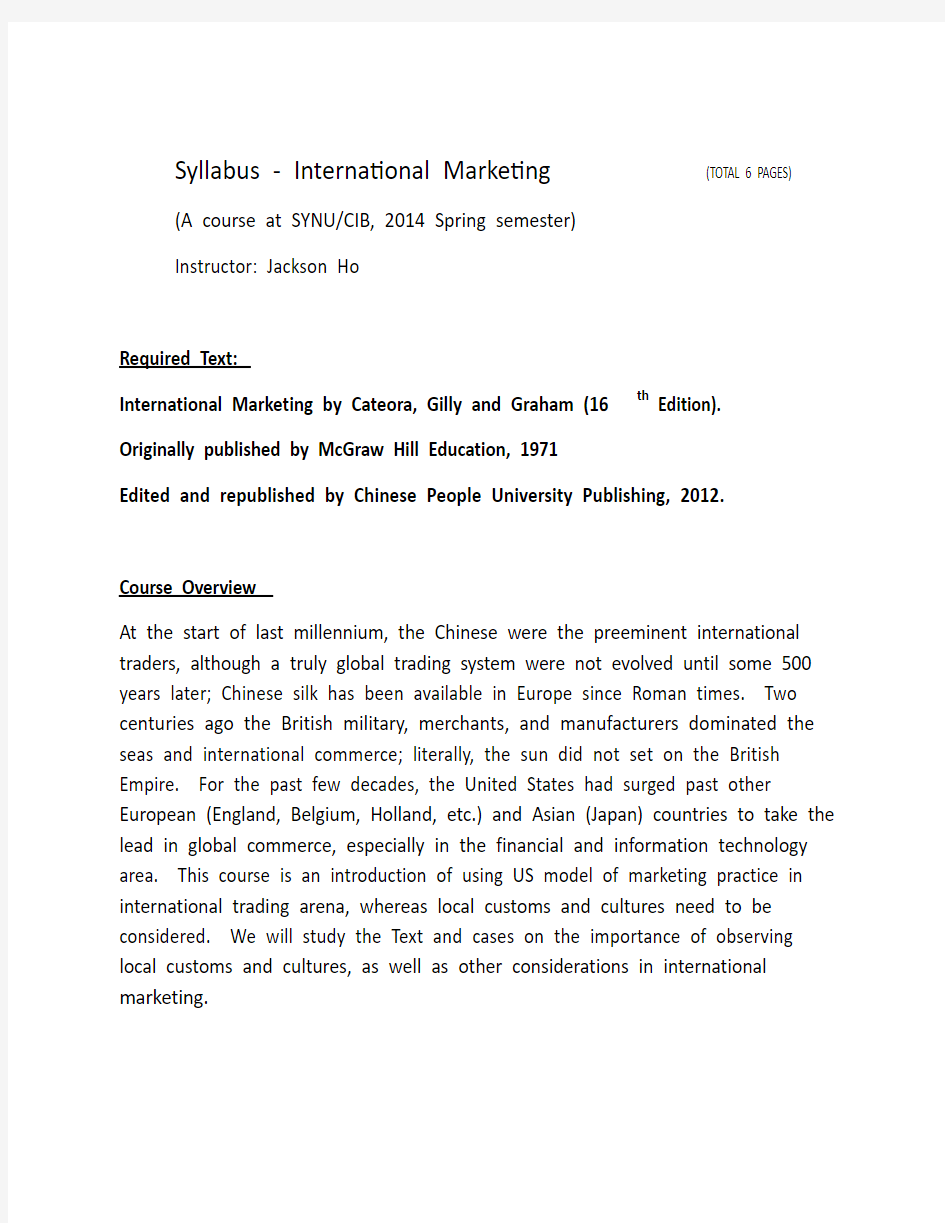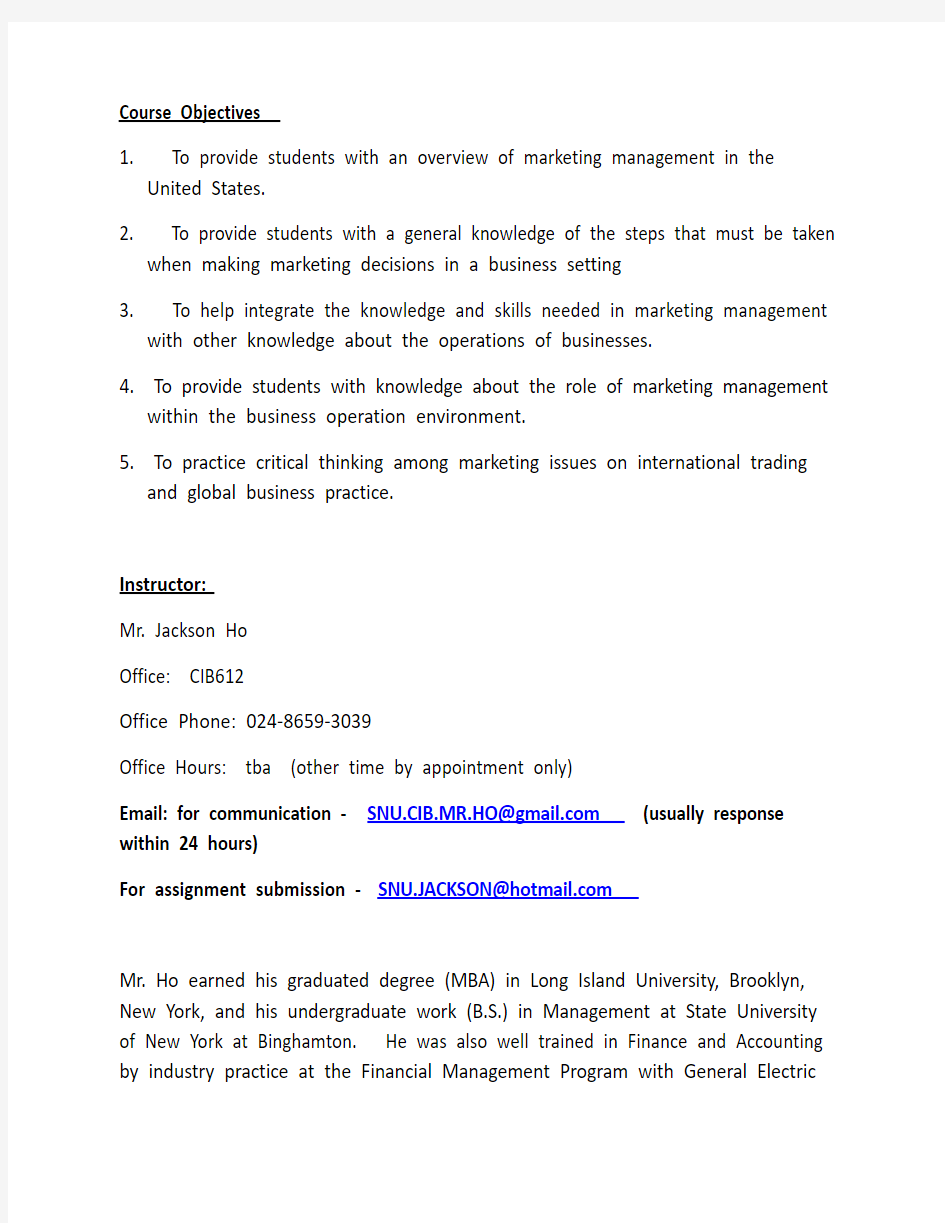Syllabus_Intl_Mktg


Syllabus - International Marketing (TOTAL 6 PAGES)
(A course at SYNU/CIB, 2014 Spring semester)
Instructor: Jackson Ho
Required Text:
International Marketing by Cateora, Gilly and Graham (16th Edition). Originally published by McGraw Hill Education, 1971
Edited and republished by Chinese People University Publishing, 2012.
Course Overview
At the start of last millennium, the Chinese were the preeminent international traders, although a truly global trading system were not evolved until some 500 years later; Chinese silk has been available in Europe since Roman times. Two centuries ago the British military, merchants, and manufacturers dominated the seas and international commerce; literally, the sun did not set on the British Empire. For the past few decades, the United States had surged past other European (England, Belgium, Holland, etc.) and Asian (Japan) countries to take the lead in global commerce, especially in the financial and information technology area. This course is an introduction of using US model of marketing practice in international trading arena, whereas local customs and cultures need to be considered. We will study the Text and cases on the importance of observing local customs and cultures, as well as other considerations in international marketing.
Course Objectives
1. To provide students with an overview of marketing management in the
United States.
2. To provide students with a general knowledge of the steps that must be taken
when making marketing decisions in a business setting
3. To help integrate the knowledge and skills needed in marketing management
with other knowledge about the operations of businesses.
4. To provide students with knowledge about the role of marketing management
within the business operation environment.
5. To practice critical thinking among marketing issues on international trading
and global business practice.
Instructor:
Mr. Jackson Ho
Office: CIB612
Office Phone: 024-8659-3039
Office Hours: tba (other time by appointment only)
Email: for communication - SNU.CIB.MR.HO@https://www.360docs.net/doc/c915982863.html, (usually response within 24 hours)
For assignment submission - SNU.JACKSON@https://www.360docs.net/doc/c915982863.html,
Mr. Ho earned his graduated degree (MBA) in Long Island University, Brooklyn, New York, and his undergraduate work (B.S.) in Management at State University of New York at Binghamton. He was also well trained in Finance and Accounting by industry practice at the Financial Management Program with General Electric
Company; Marketing and Sales Training with Xerox Company. Besides teaching Management and Marketing courses in USA and China, Mr. Ho held staff and management positions with Fortune 500 firms: IBM, GE, etc. He has been a management consultant at New York Wall Street firms for many years, clients as JP Morgan/Chase, Citi Bank, Deutsche Bank, etc. He was also affiliated with consulting firm powerhouse like Price/Waterhouse and Ernest & Young.
Class expectation:
All students are expected to attend all lectures, examinations and presentations. Student should seek prior approval from instructor should he/she anticipated an absence from the class, the student should make up the missed class from other sections. Six (6) unexcused absences will preclude the student from taking the final examination. All students are to be prepared before coming to the class (i.e. read the Text book, completed the homework assignments, etc.), it is expected all students will participate in the lecture (being asked and answer questions in the class.). Cell phones are to be set to silent mode during the class.
Final Grades:
All students are responsible to take two (2) examinations based on materials covered by the Text book and class lecture, participates in team home work assignments and team projects. Final grade are evaluated as the following,
2 examinations @ 100 points each 200
Team home work assignment – 12 @ 10 each 120
Team project – an international marketing plan 100
Attendants and class participations 100
Total 520
A = 468 and above
B = 416 and above
C = 364 and above
D = 312 and above
Failure = below 312
Academic Honest
Academic honesty is fundamental to the activities and principles of a university. All members of the academic community must be confident that each person's work has been responsibly and honorably required, developed and presented. The academic community regards academic dishonesty as an extremely serious matter, with serious consequences that range from probation to expulsion. Academic dishonesty includes but is not necessarily limited to the following: Cheating, or knowingly assisting another student in committing an act of cheating or other academic dishonesty; plagiarism; and other acts as defined by the instructor. When in doubt about plagiarism, paraphrasing, quoting or collaboration, consult the course instructor. Students are encouraged to exchange ideas about concepts, problems and group projects; however, no student may paraphrase, use or otherwise appropriate someone else’s work. As a general rule, if the student uses more than 60% of the work from sources other than his/her original work, that’s plagiarism. Students have the responsibility to know and observe the requirements of The Code of Students Academic Integrity. This code forbids cheating, fabrication or falsification of information, multiple submissions of academic work, plagiarism, abuse of academic materials, and complicity in academic dishonesty. Any special requirements or permission regarding academic integrity in this course will be stated by the instructor, and are binding on the students. The course will be conducted in accordance with University academic policies. Students are expected to adher e to the University’s policy on academic integrity as stated in the Catalog, Student Handbook and other University documents. It is the faculty member’s obligation to select or devise an academic sanction consistent with the severity of the violation. Possible sanctions may include, but are not limited to the following: the instructor may assign a failing grade for the assignment or a failing grade for the course, or may adjust the grade
as deemed appropriate. The instructor also may require the student to repeat the assignment or to perform additional assignments.
Furthermore, students are required to bring two forms of official pictured identifications to examinations (acceptable form of identification can be SNU Student ID card, SNU Campus ID card, Official Resident ID card, Official Temporary Resident ID card, Official Driver License, and Passport) as proof to his/her identity.
Students are not allowed to bring electronic devises of any sort into the examination room (example: Cell phone, Flash drive (USB drive), communication gear, etc.).
Planned class progression
Week of 3/3 Introduction,Syllabus,Chapter 1
3/10 Chapter 2… a chapter a week, homework due next week
4/14 Chapter 7, chapter 6 homework due
4/21 Exam 1 (chapter 1-7), Ch. HW and project outline due
4/28 Chapter 8… a chapter a week, homework due next week
6/2 Exam 2 (chapter 8-12), Ch. HW and Project write-up due
6/9 Project Presentation
Project Outline requirements:
Introduce the company, its industry, no. of employees, annual sales, and markets. Foreign market(s) that plans to go after.
Anticipate competitor(s) and problem(s).
Project write-up requirements:
I.Executive summary.
II.Detail analysis.
III.Budget requirement.
IV.Additional revenue expected.
V.Summation.
Chapter Homework:
Each team will email me the chapter homework in a .doc file as attachment.
The file name should be DayTeamCh.doc where,
Day=Mon or Tue or Wed or Thu
Team=team number (i.e. 01 to 10)
Ch=chapter number (i.e. 01 to 12)
All team members must participate in the discussion and the write up of the chapter homework, individual must be identified on the work.
Team
Students will form study team of five (5) members. The team will sit together in class, form discussions, does chapter homework, team project and presentation of the project. Friendships, strength and learning objectives should be considered in forming the team.
Information from the course instructor will be dissimulated through the class monitor to the team leader, then to the team members via email.
